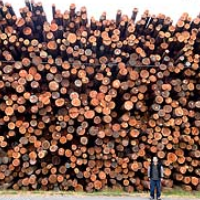U.S. Forest Service Wants to Log Burned Rim Fire Area
 (photo: Richard Wong)
(photo: Richard Wong)
Who could argue that once something burns down, if you’re sticking around, you salvage what you can and clean up the mess?
That is not a rhetorical question, and a lot of smart scientists and natural resource managers don’t agree with that thinking when applied to the Stanislaus National Forest, where the massive 69-day Rim Fire burned 275,000 acres in the Sierras four months ago. They oppose legislation introduced last September in the House of Representatives by local Republican Congressman Tom McClintock to expedite logging in the forest, another broader logging bill and a plan recently submitted by the U.S. Forest Service to “harvest” broad swaths of dead trees there.
Supporters of the measures argue that salvage operations would use the needed wood for worthwhile projects; timber companies and the local communities would profit from the activity; dead and dying trees would be put to good use; public roads would be protected from falling trees; fungus and destructive critters would be thwarted; and thinning of the forests would reduce the danger of future fire.
Chris Hanson, a forest and fire ecologist for the John Muir Protect, calls that “fearful, hyperbolic, and misinformed.” In an article for Salon, he laid out the process of “ecological restoration” that a forest goes through after a fire. In this case, a formerly mature forest will be transformed into a “snag forest” of “standing fire-killed trees, or ‘snags,’ patches of native fire-following shrubs, downed logs, colorful flowers, and dense pockets of natural conifer regeneration.”
What follows is an evolving habitat that involves black-back woodpeckers (a keystone species) carving out nesting cavities, beetle larvae, flowering shrubs attracting insects, and the return of raptors (like owls), deer, small mammals and bears.
While Hanson focused on the positive effects of not logging the burn areas, a letter (pdf) signed by around 200 scientists outlined the danger in allowing it:
“Numerous studies also document the cumulative impacts of post-fire logging on natural ecosystems, including the elimination of bird species . . . , compaction of soils, elimination of biological legacies (snags and downed logs) . . . , spread of invasive species, accumulation of logging slash that can add to future fire risks, increased mortality of conifer seedlings and other important re-establishing vegetation (from logs dragged uphill in logging operations), and increased chronic sedimentation in streams due to the extensive road network and runoff from logging operations.”
The scientists’ letter expressed opposition to legislation (H.R. 1526) that passed the House, which would suspend environmental protections to increase logging in burned and unburned forest areas alike, and H.R. 3188, which would mandate clear-cutting operations in Stanislaus National Forest without the usual public input or environmental review. Yosemite, which was originally included in the bill, was dropped.
Govtrack.us, using a complicated methodology that pays no attention to a legislation’s particulars, gave H.R. 3188 a 5% chance of passage. And that was after its most onerous feature, logging in Yosemite, was pulled. Three factors worked against it: The bill, co-sponsored by 12 Republicans, was not introduced in the first year of Congress; there were not 6+ co-sponsors on a committee to which the bill had been referred; and the bill had been referred to the House Agriculture Committee (apparently the kiss of death).
Govtrack also gave H.R. 1526 a 5% chance of success. The Obama administration has already expressed its opposition.
The U.S. Forest Service plan to log 29,648 acres in Stanislaus National Forest has divided environmentalists and sharpened debate over how much snag forest is needed for a healthy ecosystem and the importance of burn areas. The plan is currently open to public comment and a final decision is expected in August.
–Ken Broder
To Learn More:
Yosemite Fire Debate over Harvesting Burned Trees (by Peter Fimrite, San Francisco Chronicle)
Stanislaus National Forest Begins Logging Rim Fire Area (U.S. Forest Service)
Forest Service Wants to Salvage Rim Fire Timber (Associated Press)
Yosemite Pulled from Disastrous Logging Bill, but Stanislaus Forest Remains in the Crosshairs (The Wilderness Society)
Rep. McClintock Dismisses Budget Cuts, Blames Rim Fire in His District on Logging Foes (by Ken Broder, AllGov California)
House GOP OKs a Lot More Logging in California National Forests (by Ken Broder, AllGov California)
Open Letter to Members of Congress from 250 Scientists Concerned about Post-fire Logging (pdf)
- Top Stories
- Controversies
- Where is the Money Going?
- California and the Nation
- Appointments and Resignations
- Unusual News
- Latest News
- California Forbids U.S. Immigration Agents from Pretending to be Police
- California Lawmakers Urged to Strip “Self-Dealing” Tax Board of Its Duties
- Big Oil’s Grip on California
- Santa Cruz Police See Homeland Security Betrayal in Use of Gang Roundup as Cover for Immigration Raid
- Oil Companies Face Deadline to Stop Polluting California Groundwater





